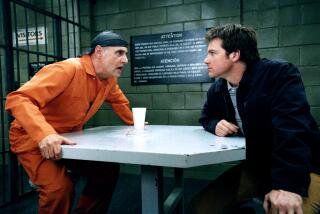Some Viewers Have ‘Shadow’ of a Doubt About Story’s Credibility
In “The Shadow,” 1930s playboy Lamont Cranston (Alec Baldwin) ends a decadent life in Tibet and returns to fight crime in New York after a magical metamorphosis gives him powers to become invisible and to know telepathically what evil lurks in the hearts of men. (Rated PG-13)
*
This is the type of comic book movie that produces arguments among boys who have just entered the age of reason and technical detail. Like, for instance, why does his nose change when he turns into The Shadow? And, if he has all these great powers, how come he doesn’t get out of all those sticky situations that drive the plot?
Either you go with it or you don’t.
Twelve-year-old Faud Haghighi didn’t. “It wasn’t very realistic. It was boring.”
Boring? High-tech special effects that begin with a knife whose carved head comes to life and obeys the will of the strongest mind? Concrete-shoe victims and vintage-car chases that are more exciting than the ‘30s originals? A nemesis descended from Ghengis Khan who controls a scientist’s mind to set off a two-hour time bomb to destroy New York? A smart blonde in a satin backless dress?
What about the rainy city street sets that captured the neon and nighttime mood of a detective story? Too dark, he said.
“I thought the special effects were good,” countered Faud’s friend Sean Duenser, 11. “The knife was cool and the telepathic things.”
“The mind control made it more confusing!” Faud said.
“So? That’s what I liked! It was a good movie.”
Faud, as an aside: “The only reason he liked the movie is because Alec Baldwin was in it.”
“He’s cool! He was good in ‘Malice,’ too!”
Tim Lee, 12, thought it was boring for another reason. “The plot was sort of dull,” he said.
His 8-year-old brother, Artie, had questions about the invisible part.
“When they were fighting, why didn’t they just turn invisible and punch the guy? He can’t see you.”
Replied their friend David Shaw, 12, “No. No. No. Have you seen ‘Memoirs of an Invisible Man?’ He’s in the rain and you can see him although he’s invisible because of the rain.” He paused. “It’s complicated.”
Said Artie: “You should still, when you’re fighting, get an advantage!”
Artie also was excited he could figure out the old-fashioned, comic-book crime-fighting techniques.
“Where you couldn’t see it, that’s invisible ink,” he explained. “How he wrote on paper, but you couldn’t see anything, but when the people read it, there was writing. It was like invisible, reappearing ink!”
No kids of course remembered the 1931 radio series that inspired the movie. Heck, I don’t even recall it.
To David, the movie seemed to be a “weird” combination of “Batman” and “Beetlejuice.” I might throw in “The Thin Man” considering the mutually respectful crime-fighting pair of Cranston and the equally telepathic Margo Lane.
The rating is on target. Other than an opening orgy scene in Tibet, sex is implied obliquely with double-entendres, and though plenty of people fall to their deaths from skyscrapers, the blood doesn’t get gory, a la “Batman.”
“For a PG-13 movie,” said David, “it was pretty good.”
More to Read
Only good movies
Get the Indie Focus newsletter, Mark Olsen's weekly guide to the world of cinema.
You may occasionally receive promotional content from the Los Angeles Times.










